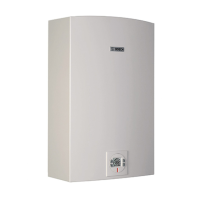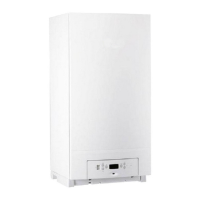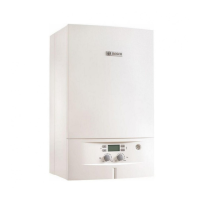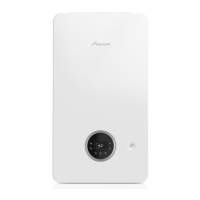Engineering information and sizing
33
Systemlösung – 6 720 885 509 (2018/03)
Sizing of key flue system from CHP
The total resistance of the flue system is the total of the
individual resistances in the pipework. Any rear silencers
planned (secondary exhaust gas silencer, accessories)
should also be taken into consideration.
The most important parameter for sizing the flue system,
apart from the flue gas mass flow rate and the flue gas
temperature, is the permissible flue gas back pressure.
• Exceeding the permissible flue gas back pressure has
a significant effect on components, output, fuel
consumption and thermal load of the engine.
• Chart 16 contains the available pressure drops for
flue system from/downstream of sound insulation of
the CHP.
• The pressure drop for the 4-draught steam boiler and
the downstream flue gas heat exchanger (ECO2) is
also given.
• The available pressure drop for flue gas system sizing
comprises the line from/downstream of the silencers
of the CHP to entry of the 4-draught system and
downstream of flue gas heat exchanger (ECO2) to
chimney outlet.
Sound insulation on the flue gas side CHP
The sound pressure levels of a flue system depend on a
wide variety of factors. The materials used, the diameter,
the height of the flue system and, not least, the number
of deflections present are just some of the factors which
influence the sound pressure level.
The most reliable method is to specifically design the
flue gas silencers once the CHP module has been
commissioned. If this is not possible, plan from the
outset to leave at least enough space for silencers to be
installed later on.
The project requirements must be considered with
respect to the noise emissions. These requirements
usually make the use of sound-isolated installations and
secondary or tertiary silencers necessary.
The following must be provided for every individual flue
gas pipe:
• Mating flange for CHP module outlet flange
• Axial expansion joint to separate structure-borne
noise and absorb thermal stresses (flexible
connection accessory construction set page)
• Pipework and fittings
• Secondary flue gas silencers and possibly tertiary
silencers designed for special ignition frequency
requirements (option, accessories)
• Cleaning and drainage connections and test nipples
• If applicable, a wall outlet from the installation room
outside to the chimney
• Insulation suitable for flue gas temperatures up to
650 °C
• Certificate confirming that the system is safe to use
(pressure test; pressure log)
Unit Electrical output CHP
240 400 600 800 1200 1560 2000 854 1287 1718 1999
[kW] [kW] [kW] [kW] [kW] [kW] [kW] [kW] [kW] [kW] [kW]
Flue gas temperature without
flue gas heat exchanger
°C 570 440 453 452 414 426 410 443 440 426 455
Maximum flue gas temperature °C 650 650 550 550 550 550 550 550 550 550 550
Flue gas tube dimension – DN 150 DN 200 DN 300 DN 400 DN 400 DN 500 DN 500 DN 300 DN 400 DN 500 DN 500
Flue gas mass flow rate (wet) kg/h 921 2083 3343 4418 6551 8665 10983 4524 6700 8940 10832
Available flue gas back
pressure for flue downstream
of silencer
mbar 15 17 25 25 25 25 25 25 25 25 25
Flue gas counter pressure,
reserved from this, for boiler
(incl. flue gas damper for
variant with bypass)
mbar 10 10 15 15 15 15 15 15 15 15 15
Available pressure drop for
sizing of flue system
mbar 5 7 10 10 10 10 10 10 10 10 10
Table 16 Specifications for sizing the flue
The flue system has to be planned in acc.
with the local conditions concerning
required pipe length and deflections with
the maximally available pressure drop.

